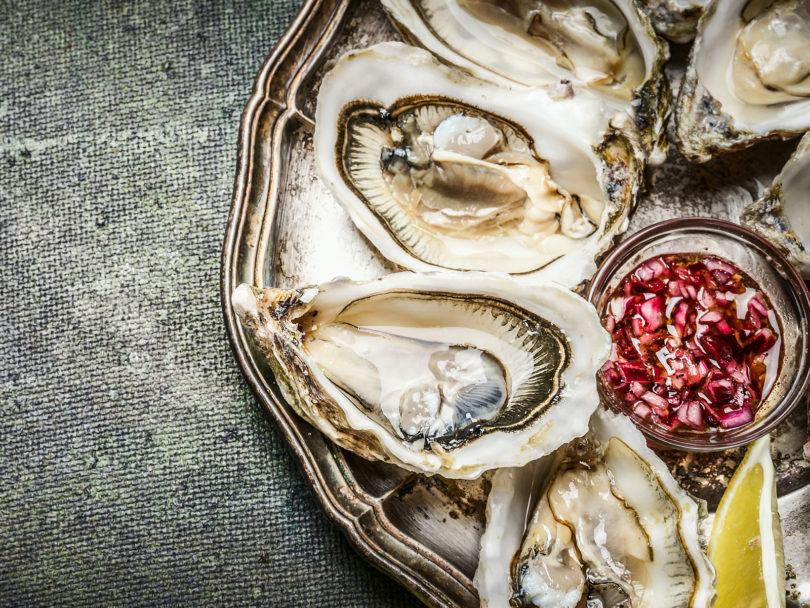Modern life is all about shortcuts. We’re all looking for faster, easier and more efficient ways to do the most complicated parts of our lives. This applies to love and romance, too. Romance in the 21st century is a multi-billion dollar industry, one where apps and algorithms act as matchmakers, and swiping your thumb left or right on your smartphone can be the difference between connecting with someone or not.
One aspect of human romantic relationships that futuristic and intelligent technology can’t seem to crack is a person’s sex drive. There’s no algorithm for increasing libido … yet.
So, what do you do if your sex drive is really stuck in neutral this Valentine’s Day? There’s no app for making you want to “do it” more — unless by “app” you mean appetizer.
What if the modern shortcut to turning up the heat between the sheets was actually something as primal as food? The idea that certain kinds of foods and their nutritional or mystic qualities might possess an extra oomph in each bite goes back thousands of years.
Aphrodisiacs — named after the Greek goddess of love Aphrodite — are foods traditionally believed to increase libido to varying degrees. Using food to increase sex drive goes back to the time of the accomplished Roman doctor Galen, who wrote that foods that were most similar to sex were the most likely to induce lust. Galen’s belief — held by some to this day — was that “warm and moist” foods were natural aphrodisiacs.
The influences of aphrodisiacs and the beliefs behind them span across cultures and history. Different cultures valued different properties of foods that made them inherently more sexual than others. Often, foods were believed to be aphrodisiacs simply because they were rare. For example, potatoes were once delicacies in Europe and believed to increase one’s sex drive. If only it were as easy as eating French fries!
In Western European and American cultures, some of the most common aphrodisiacs are oysters, strawberries and chocolate. But across the world, the list of foods believed to increase sexual desire varies greatly, from sea cucumbers in China to baboon urine in Zimbabwe.
The question surrounding aphrodisiacs remains: Do they work? Can a fig really boost sexual stamina? Does munching on asparagus really increase blood flow, um, down there?
The science of aphrodisiacs remains inconclusive. Several studies have been conducted to reveal the true efficacy of different foods used to increase sex drive, but most have revealed that there is no scientific evidence to support the idea that food plays any role in increasing libido.
A July 2015 study by doctors Elizabeth West and Michael Krychman in the journal of the International Society for Sexual Medicine explored which aphrodisiacs were scientifically worth trying. The study analyzed data from 50 other scientific studies related to the science of food and sex.
What did they find? Chocolate and oysters, the most famous foods thought to be aphrodisiacs, probably don’t do a thing to increase sex drive. What the study did find, however, was that the food most likely to get you in the mood was ginseng. Ginseng, a root commonly used in tea and energy drinks with a plethora of possible health benefits, works as a natural stimulant that can increase blood flow and stamina.
Before embarking on a sexual buffet of new and unusual foods this Valentine’s Day, though, be sure to consult with your doctor, as certain foods and ingredients commonly thought to increase sex drive can also have unintended side effects if you’re not used to them. For example, gingko — one popular aphrodisiac — can be taken as a supplement, but has potential side effects that include dizziness and nausea.
And beware of the legendary love drug Spanish fly. Ingesting it might cause a rush of blood to the nether regions, but it can burn the mouth and throat and cause urinary infections and in extreme cases, death. Plus, it’s made from dried beetle dung, and who wants to eat that?
According to Shakespeare, “If music be the food of love, play on,” but for many seeking out ways to make this Valentine’s Day truly spicy — food is the food of love.
Want to spice up your love life?
If you’re looking to heat up the bedroom, try whipping up some of these aphrodisiac-filled dishes:
Start with a Pomegranate & Arugula Salad Try a few Raw Oysters before the main course Spice up your meal with Ginger Chili Citrus Salmon Move on to dessert with a dozen romantic Chocolate-Dipped Strawberries And don’t forget the wine!


